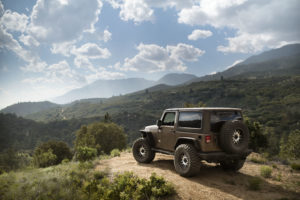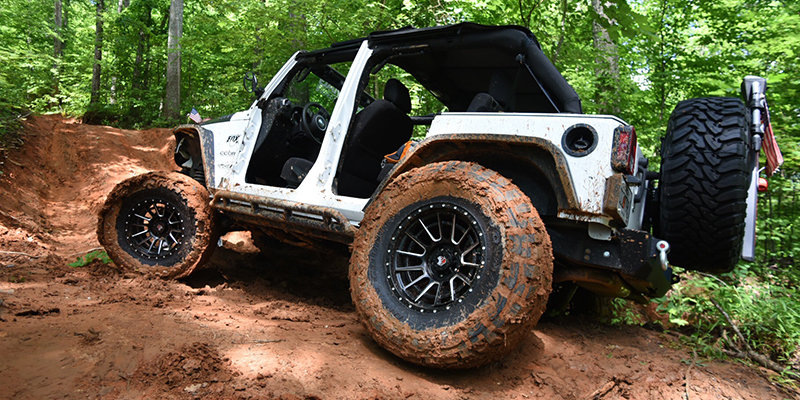Several decades ago, our world seemed a lot more simple mostly because we had fewer choices. Since that time, vehicle technology has advanced by leaps and bounds, creating more options to match both our active lifestyles and our work environments.
Vehicles and their tires have also changed significantly. For instance, light trucks were sold new from the dealership with tires that had a highway tread design. If the truck owner wanted to install a different tire for greater traction, he or she would generally turn to the aftermarket for a winter tire or a more capable aftermarket off-road tire.
Today, consumers can walk into a showroom and purchase much more specialized trucks: platforms that are either great for load hauling or are designated as “off-road” or “sport truck” editions. Many of those options are thanks to a burgeoning aftermarket industry that also developed during those years and helped to influence today’s vehicle trends.
Mud terrain or “MT” tires were once used almost exclusively by farmers but are now commonly used to provide traction for off-road vehicles. You can regularly find throngs of Jeep owners enjoying their weekends on the trails with MT tires, and now you see modified trucks with heavy chassis and big loads traveling the highways wearing MT tires. The trend by these light truck and SUV owners to customize their rigs created an entirely new set of MT design challenges.
Design Considerations
As avid outdoor and off-road enthusiasts, the engineers I work with understand how important it is to have an MT tire that performs extremely well on-road as well as when the pavement ends. Most consumers are not familiar with the trade-offs normally associated with an MT tire. Generally speaking, off-road tires will generate more noise, more rolling resistance and wear faster than a highway-terrain pattern. Therefore, tire engineers have the difficult task to design and develop MT tire designs and rubber compounds to provide off-road grip and on-road performance, too.
For example, when developing our Toyo Open Country M/T, the development team studied the market. They joined consumers across the country to experience how they used their vehicles. This gave the team a better understanding of capabilities and performance requirements.
Engineers were able to take this valuable in-field experience and combine it with our advanced design and manufacturing technologies to create a mud-terrain tire that exceeded customer expectations, balancing off-road performance and on-road manners with low noise and long tread life.
Ultimately, it all comes down to developing a tire that exceeds the customer’s expectations in all areas.
MORE: Take a look at Tire Review’s October 2018 Digital Edition
Traction and Tread
Traction and durability off-road are essential. Engineers design each product for its application. For instance, subtle variations in tread design will impact performance in mud, sand and snow, and sidewalls on better quality products are often designed to help resist cuts and punctures. The tread compound must work in concert with the tread pattern to provide off-road grip and to work well in wet conditions.
With that, it’s important to note that not all tires are the same.
Proprietary tire construction techniques by the various MT tire manufacturers allow for unique design features, so it’s important to familiarize yourself with those key features and design elements that are unique to each product you offer.
MT tires have a large tread void area, which is necessary to allow the mud to “clean-out” between the tread lugs for traction. Tread lug durability and stability is greatly affected by the rubber compounds. These tread lugs must be durable enough to provide traction and withstand the abuse of climbing boulders, tree roots, gravel, etc.
Siping is important for on-road wet performance, but it’s less important when driving off-road, especially in mud and dirt. MT tires generally have less siping to allow for strong tread lugs.
The grip is as important as the impact protection and puncture resistance.
When it comes to driving in sand and snow, many off-roaders will want a large, wide contact patch to spread out the weight across the tire footprint. On the other hand, some prefer a “tall and skinny” off-road tire, which improves ground clearance and concentrates the vehicle’s weight to provide traction in dirt and mud.
Making the Right Recommendation
The key to making a proper off-road tire recommendation starts with understanding the needs and desires of your customer as well as the capabilities of their vehicle. The first step is to ask the customer what is important to him or her in a tire and then ask how they plan to use their vehicle. Then, listen closely to their response and make a recommendation designed to meet that customer’s wants and needs.
With light truck products and various lifestyles, asking the right questions and listening closely to understand what the customer is looking for in a replacement tire will help in selecting the right tire for the individual.
- Do they intend to spend most of their time off-road?
- Do they use it for work, take the family camping on the weekends or haul a boat to the lake?
- Do they tow and, if yes, how much weight will they be towing?
- Do they spend most of their time driving around loaded or unloaded?
- Do they want quiet on-road manners?
- Do they prioritize the look of the tire? Are they driving in severe winter conditions?
As an example, if the customer lives in Northern California and will be rock crawling in their modified Toyota FJ Cruiser, I’m going to recommend an MT tire equipped with a large sidewall to protect the wheel from impacts. The MT’s large, durable lugs offer excellent traction and durability too.
If the customer lives in Texas and drives a leveled Ford F-150 Platinum grade with 20-in. wheels that will be used off road but will also spend a fair amount of time on pavement and towing a family boat, I am going to recommend an all-terrain (AT) tire.
Changing Tire Size
When buying new off-road tires, many truck and SUV owners will upgrade their wheels and/or go with a larger tire to increase ground clearance and achieve a more aggressive look for their ride. The dealer must ensure that the replacement tire meets or exceeds the vehicle load capacity at the required inflation pressure. A common misconception, but a common practice, is for customers to install larger tires than what came on their truck or SUV, many times changing them from a P-Metric to LT-metric and running their tires underinflated.
If a larger size than the factory tire is fitted, then tire pressure will need to be adjusted accordingly to ensure the tires will safely carry the load. The correct pressures can be determined by using the tables found in the Tire and Rim Association’s Year Book. If you do not have access to the tables, you can find them at www.toyotires.com; or, you can call the technical service hotline at 800-442-8696, where Toyo Tire experts can help you determine the proper replacement inflation pressures.
Proper inflation is key to having the ideal tread contact patch on the ground surface. A common misconception is that tires should be deflated for off-road use. Yes, in some cases, airing down tires can be beneficial for traction on soft surfaces; however, air down too much and you reduce the tension on the bead area, which can be severely damaged or can lose its seal to the wheel under a side load. An under-inflated tire may lead to damage from a pinched sidewall. It is best to keep the tires properly inflated. If you come up to an obstacle that requires you to air down, do so with caution and re-inflate before getting back on the road. It doesn’t take long to ruin a tire by driving on it under-inflated down the road due to the additional heat buildup in the casing.
Tire dealers have the advantage of experience. Dealers will want to outfit their customers’ vehicles with replacement tires that are safe and with correct fitments that exceed their customers’ expectations for quality and performance while achieving the look they desire for their trucks or SUVs. It is also imperative that the customer isn’t going to come back with drivability or ride complaints.
As you can see, the customers’ preferences for MT tires, vehicle changes and off-road usage have evolved immensely. As a result of these changes, the MT tire has had to evolve to meet the needs and desires of today’s customer. Rather than just being a dedicated “trail tire,” the MT has become a performance and style add-on, whether the buyers have a Jeep, SUV, crossover, mid-size or full-size pickup. TR
Todd Bergeson is senior manager for product planning and technical services at Toyo Tire U.S.A. Corp. Special thanks to Jay Jones for his contribution to this article. For more information on the Toyo Open Country line of products including M/T, R/T and A/T II, visit www.toyotires.com/opencountry.














